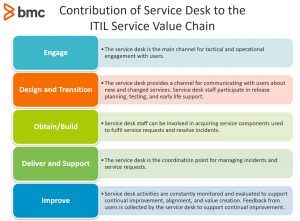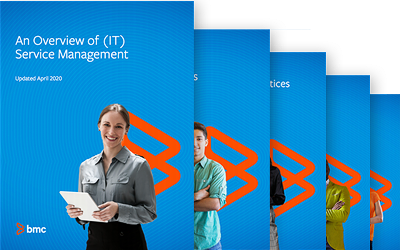The purpose of the service desk practice is to capture demand for incident resolution and service requests. It should also be the entry point and single point of contact for the service provider with all of its users. It provides a clear path for users to report issues, queries, and requests, and have them acknowledged, classified, owned, and actioned.
Over time, the focus of service desks has broadened from simply logging and resolving technical issues, to proving more comprehensive support for people and the business. They are increasingly being used to get various matters arranged, explained, and coordinated. The service desk has a major influence on user experience and how the service provider is perceived by the users. By understanding and acting on the business context of transactional activity (i.e. logging tickets), the service desk is better placed to add value to the organization.
Download Now: ITIL 4 Best Practice e-Books
These all-new for 2020 ITIL e-books highlight important elements of ITIL 4 best practices. Quickly understand key changes and actionable concepts, written by ITIL 4 contributors.
With increased automation, AI, robotic process automation (RPA), and chatbots, service desks are moving to provide more self-service logging and resolution directly via online portals and mobile applications. The impact on service desks is reduced phone contact, less low-level work, and a greater ability to focus on the customer experience benefits of personal contact.
Service Desk Channels
Service desks provide a variety of channels for access including:
- Phone calls, which can include specialized technology, such as interactive voice response (IVR), conference calls, voice recognition, and others.
- Service portals and mobile applications, supported by service and request catalogues, and knowledge bases.
- Chat, through live chat and chatbots.
- Email for logging and updating, and for follow-up surveys and confirmations.
- Walk-in service desk (which are becoming more prevalent in some sectors, such as higher education, where there are high peaks of activity that demand physical presence).,
- Text and social media messaging, which are useful for notifications in case of major incidents and for contacting specific stakeholder groups, but can also be used to allow users to request support.
- Public and corporate social media and discussion forums for contacting the service provider and for peer-to-peer support.
Service Desk Models
How the service desk practice is managed and delivered may vary from a physical team of people on shift work, to a distributed mix of people connected virtually. The use of automated technology and bots is increasing. Regardless of the model, the function and value remains the same. Service desks use supporting technologies such as:
- Intelligent telephony systems, incorporating computer-telephony integration, IVR, and automatic call distribution
- Workflow systems for routing and escalation
- Workforce management and resource planning systems
- A knowledge base
- Call recording and quality control
- Remote access tools
- Dashboard and monitoring tools
- Configuration management systems
Where the service desk is a virtual, it allows agents to work from multiple locations, geographically dispersed. A virtual service desk requires more sophisticated supporting technology, involving more complex routing and escalation (these solutions are often cloud based).
Service Desk People
However efficient the service desk and its people are, there will always be issues that need escalation and underpinning support from other teams. Support and development teams need to work in close collaboration with the service desk to present and deliver a ‘joined up’ approach to users and customers.
Service desk staff require training and competency in both technical and business skills, especially customer service skills such as empathy, incident analysis and prioritization, effective communication, and emotional intelligence. A key skill is to be able to fully understand and diagnose a specific incident in terms of business priority, and to take appropriate action to get this resolved, using available skills, knowledge, people, and processes.
Contribution of Service Desk to the Service Value Chain
Service Desk is involved in all service value chain activities (mainly engage and deliver and support) except the plan activity as shown below:
| Engage | The service desk is the main channel for tactical and operational engagement with users. |
| Design and Transition | The service desk provides a channel for communicating with users about new and changed services. Service desk staff participate in release planning, testing, and early life support. |
| Obtain/Build | Service desk staff can be involved in acquiring service components used to fulfil service requests and resolve incidents. |
| Deliver and Support | The service desk is the coordination point for managing incidents and service requests. |
| Improve | Service desk activities are constantly monitored and evaluated to support continual improvement, alignment, and value creation. Feedback from users is collected by the service desk to support continual improvement. |

ITIL® is a registered trade mark of AXELOS Limited. IT Infrastructure Library® is a registered trade mark of AXELOS Limited.








